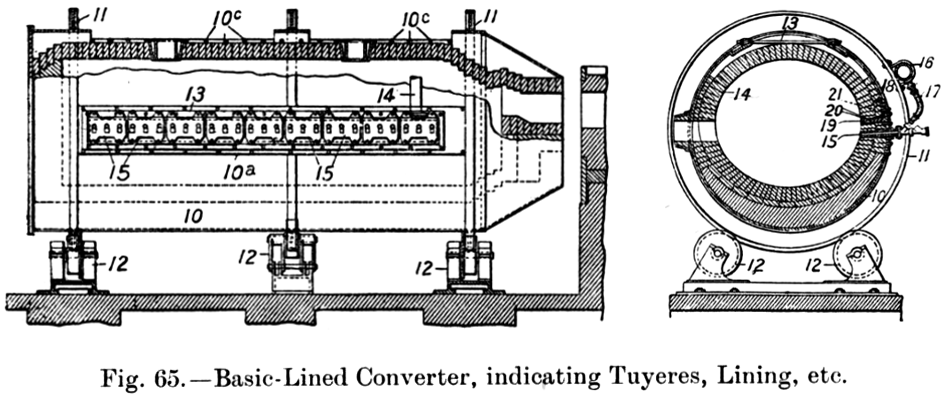William H. Peirce on:
[Wikipedia]
[Google]
[Amazon]
William H. Peirce (died 1944) was an
 The , developed in 1908 with
The , developed in 1908 with
/ref> A reduction of the cost of copper converting from 15–20 USD to 4–5 USD has been stated. The Peirce-Smith converter quickly replaced the Manhès–David converter: by March 1912, the Peirce-Smith Converting Co claimed that "over 80% of the copper produced in
American
American(s) may refer to:
* American, something of, from, or related to the United States of America, commonly known as the "United States" or "America"
** Americans, citizens and nationals of the United States of America
** American ancestry, pe ...
civil engineer
A civil engineer is a person who practices civil engineering – the application of planning, designing, constructing, maintaining, and operating infrastructure while protecting the public and environmental health, as well as improving existing ...
and metallurgist
Metallurgy is a domain of materials science and engineering that studies the physical and chemical behavior of metallic elements, their inter-metallic compounds, and their mixtures, which are known as alloys.
Metallurgy encompasses both the sc ...
, who pioneered copper production in the early 20th century. Among his achievements was the , invented with Elias Anton Cappelen Smith
Elias Anton Cappelen Smith (6 November 1873 – 25 June 1949) was a Norwegian American chemical engineer, civil engineer and metallurgist. He pioneered copper production in the early 20th century. Among his achievements were the and the Guggenh ...
.
Life
He joined the '' Baltimore Copper Smelting & Rolling Company'' in 1890, becoming vice president in 1895, and later, president of the company. Under his management, the company became one of the major copper producer of the United States. In 1928, the company merged with five other copper companies, to create the Revere Copper Company. Described as "one of the foremost metallurgists of his time", Peirce became the vice president, director and a member of the Executive Committee of Revere from its incorporation in 1928 until his resignation in 1933.Invention of the Peirce–Smith converter
 The , developed in 1908 with
The , developed in 1908 with Elias Anton Cappelen Smith
Elias Anton Cappelen Smith (6 November 1873 – 25 June 1949) was a Norwegian American chemical engineer, civil engineer and metallurgist. He pioneered copper production in the early 20th century. Among his achievements were the and the Guggenh ...
, significantly improved the converting of copper matte.
Before this invention, the converter was a cylindrical barrel, lined with an acid
In computer science, ACID ( atomicity, consistency, isolation, durability) is a set of properties of database transactions intended to guarantee data validity despite errors, power failures, and other mishaps. In the context of databases, a sequ ...
refractory lining, made of sand and clay. It was developed by two French engineers, Pierre Manhès
Pierre Manhès (1841 – 1906) was a French metallurgist and businessman, who succeeded in 1880 to adapt the Bessemer process to the pyrometallurgy of the copper. With his engineer , he developed the Manhès-David process and converter, which w ...
and from 1880 to 1884. Their copper-converting process, named the Manhès–David process
The Manhès–David process is a refining process of the copper mattes, invented in 1880 by the French industrialist Pierre Manhès and his engineer . Inspired by the Bessemer process, it consists of the use of a converter to oxidise with air ...
, was directly derived from the Bessemer process. In this horizontal chemical reactor, where air was injected into copper matte, a molten sulfide
Sulfide (British English also sulphide) is an inorganic anion of sulfur with the chemical formula S2− or a compound containing one or more S2− ions. Solutions of sulfide salts are corrosive. ''Sulfide'' also refers to chemical compounds lar ...
material containing iron, sulphur and copper, to become molten blister, an alloy containing 99% copper. But the basic
BASIC (Beginners' All-purpose Symbolic Instruction Code) is a family of general-purpose, high-level programming languages designed for ease of use. The original version was created by John G. Kemeny and Thomas E. Kurtz at Dartmouth College ...
slag produced during the blowing combined with the acid silica refractory lining, thereby causing a very short lifetime of the lining.
By developing a basic refractory material adapted to the matte refining process (in magnesia bricks), Peirce and his engineer Smith found a way to drastically increase the lifetime of the lining. It has been stated that, in some cases, the process allowing an increase from 10 to 2500 tons of copper produced without relining the converters.''William Peirce and E.A. Cappelen Smith and Their Amazing Copper Converting Machine''(Larry M. Southwick. “JOM: The Member Journal of TMS” . International Peirce-Smith Converting Centennial. October 2008 Volume 60, No. 10)/ref> A reduction of the cost of copper converting from 15–20 USD to 4–5 USD has been stated. The Peirce-Smith converter quickly replaced the Manhès–David converter: by March 1912, the Peirce-Smith Converting Co claimed that "over 80% of the copper produced in
he U.S.
He or HE may refer to:
Language
* He (pronoun), an English pronoun
* He (kana), the romanization of the Japanese kana へ
* He (letter), the fifth letter of many Semitic alphabets
* He (Cyrillic), a letter of the Cyrillic script called ''He'' i ...
is being converted either in P-S type converters or on basic lining, under license, in the old acid shells".
It is still in use today, although the process has been significantly improved since then. In 2010, with 250 converters working in the world, the Peirce-Smith converters refine 90% of the copper matte.
Honors
In 1931, Peirce, still president of the ''Baltimore Copper Smelting & Rolling Co.'', as well as being ''President of the Peirce-Smith Converter Company'' and vice president of the ''American Smelting & Refining Company'', is awarded of the James Douglas medal, for "his numerous improvements in devices for smelting, refining, and rolling copper".References
{{DEFAULTSORT:Peirce, William H. American civil engineers 1944 deaths History of metallurgy